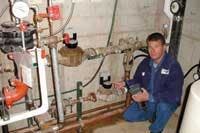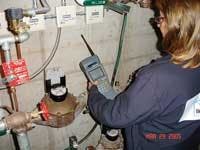Metering System Offers Utility “Power of Choice”
The Department of Utilities for the City of Fountain, CO, implemented an AMR (Automated Meter Reading) system to improve meter reading efficiency for its growing customer base. As a combination water and electric utility, the department required a system with the capacity to read both its electric and water meters.
Meter accuracy was improved with initial upgrades, but the initial AMR System implementation required meter readers to carry separate handhelds for water and electric meters. The final solution was an AMR system from Neptune, a combination of RF (Radio Frequency) handhelds and mobile data collection units capable of reading both electric and water meters coordinated through a single meter reading management software.
Located just outside Pueblo and Colorado Springs, Fountain is a growing city, adding 250 - 300 new homes per year. Providing service to the ever-increasing population presented a challenge to the City of Fountain Department of Utilities, which has seen its customer base double to 13,633 services over the last 20 years.
Before the conversion to AMR, meter readers used a manual meter reading process, which required access to yards and homes. The utility was forced to address a variety of meter access issues including meters in pits, in homes, and behind fences. Often readers had to schedule appointments with residents to gain access to the meters.
In 1999 the city determined that its meter reading system had reached the end of its useful life. To address its growing customer base, the City Council decided to look at alternative meter reading systems in conjunction with the needed meter change-out.
The conversion started in the second half of 1999.
“We went from paper and pencil reading,” said Linda Chalou, Utility Analyst, City of Fountain Colorado, “to manual reading, inputting the reads into a handheld device from Radix. Then we converted to an AMR system from Itron. The Itron system worked wonderfully for reading electric meters; however, we experienced many difficulties reading the water meters.”
Fountain needed a better option. In an effort to improve meter reading efficiency, Fountain evaluated adding a mobile meter reading unit. Itron’s mobile unit performed well with the electric meters but demonstrated the same difficulty reading the water meters as the handheld. The Department of Utilities decided to replace the old Badger meters and Itron water ERTs with Neptune water meters and R900s and purchased Neptune’s PC9300 handheld unit. The combination of Itron’s handheld equipment for reading electric meters and Neptune’s handheld for water meters was functional but cumbersome. Meter readers were burdened with carrying two handheld units.
As a result, Fountain added one of Neptune’s mobile data collectors capable of reading electric ERTs / R300s and water R900s. Neptune’s meter reading software coordinates the routes for both electric and water meter reading using both the handhelds and the mobile units, and allows Chalou to manage all of the incoming readings.
In 2004, Itron’s proposed merger with Schlumberger’s Electricity Division prompted the Federal Trade Commission to instruct Itron to grant license rights to Neptune (and Neptune’s wholly owned subsidiary DB Microware.) In 2004 Neptune announced that it had concluded negotiations with Itron granting Neptune the right to continue to sell electric ERT compatible mobile meter reading systems.
“We are very pleased that Neptune will be able to continue to offer the market a choice of systems to read their electric ERTs and R300s,” said Charles C. DiLaura, President of Neptune Technology Group Inc.
Fountain purchased three additional Neptune handheld units.
“We initially added the Neptune handhelds to read only water accounts, but are now using only the Neptune AMR system for both electric and water,” Chalou said.
The conversion to Neptune’s AMR system took only 18 months and has shown dramatic results. Meter reading hours have been cut from 120 hours a week with manual entry to 80 hours a week with handhelds, and only eight hours with the mobile unit. Fountain has also seen a decline in the number of monthly re-reads from five percent with manual entry to less than one percent with AMR.
The time savings have allowed Fountain to expand the responsibilities of its field representatives. Two full time service people are able to read the meters, which used to require the assistance of two additional personnel. The same two field representatives can now also manage all move-in and move-out reads, address non-pays and trouble shooting for customers. Meter readers no longer require access to customer property, which has improved reader safety and improved customer service. Also, customer complaints have decreased due to the accuracy of the system.
With thorough training from Neptune, Chalou is able to manage the entire system alone. The company’s meter reading software allows Fountain to manage its handheld and mobile electric and water meter readings with a single software platform.
Pleased with the results of system, Fountain agreed to serve as a test site for the next generation of Neptune’s handheld units in hopes of improving revenue, efficiency and customer service even more.
For more information contact: Linda Chalou, Utility Analyst, City of Fountain, at 719-322-2047. Or visit www.fountaincolorado.org. WW



